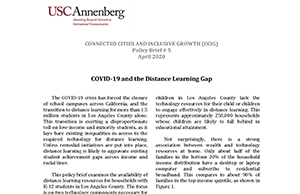CONNECTED CITIES AND INCLUSIVE GROWTH (CCIG)
Policy Brief # 5 April 2020
COVID-19 and the Distance Learning Gap
The COVID-19 crisis has forced the closure of school campuses across California, and the transition to distance learning for more than 1.5 million students in Los Angeles County alone. This transition is exerting a disproportionate toll on low-income and minority students, as it lays bare existing inequalities in access to the required technology for distance learning. Unless remedial initiatives are put into place, distance learning is likely to aggravate existing student achievement gaps across income and racial lines.
This policy brief examines the availability of distance learning resources for households with K-12 students in Los Angeles County. The focus is on two technology components necessary for effective distance learning: a desktop or laptop computer and a residential Internet connection. This assumes that, for a variety of reasons, mobile broadband services and devices fall short of meeting the needs of K-12 students for distance learning. The data is sourced from the American Community Survey (ACS) 5-year estimates for 2018, the latest year available.
Connected Cities and Inclusive Growth (CCIG) is a collaboration: USC Annenberg Research Network for International Communication (ARNIC) and the USC Price Spatial Analysis Lab (SLAB).
More information about the project can be found at arnicusc.org/research/connected-cities.

